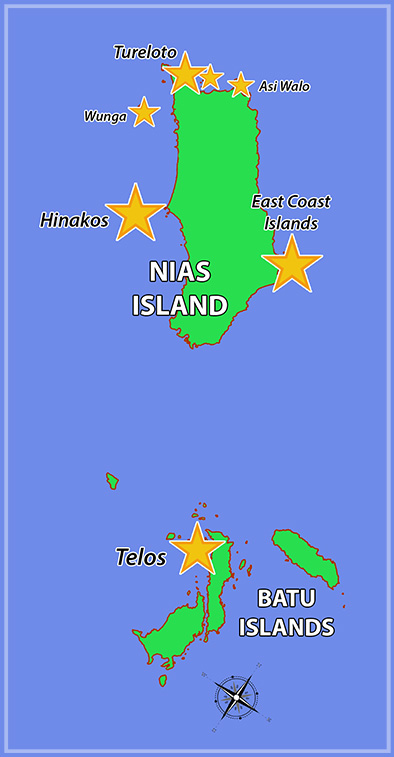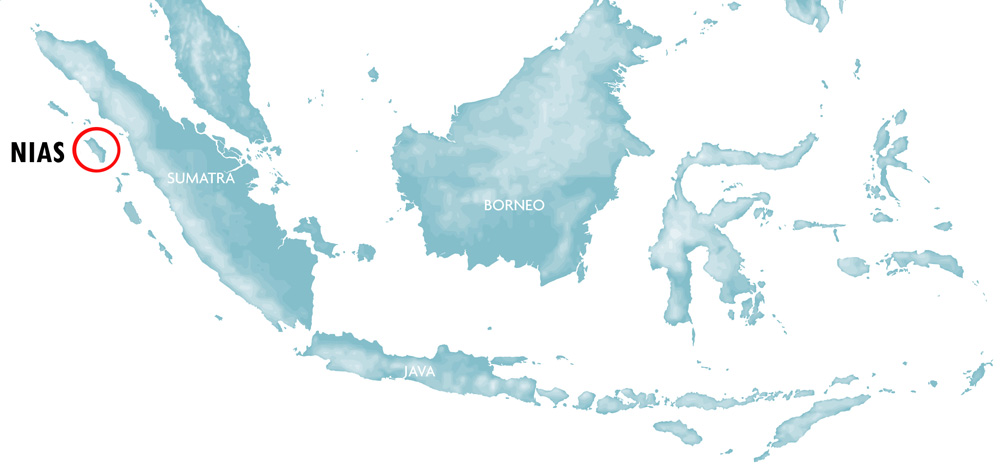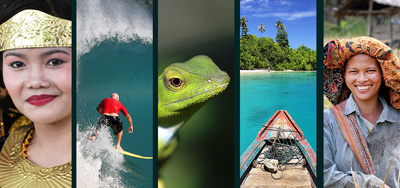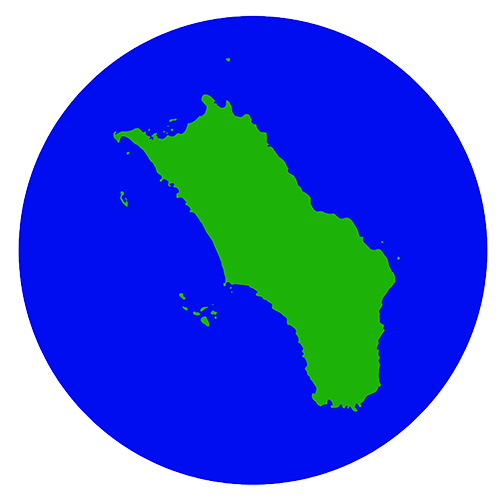Snorkelling and Diving on Nias Island
The clear, warm water and the abundance of tropical marine life makes snorkelling and freediving on Nias Island an amazing experience! Many good snorkelling spots can be found along the coast and are easy to get to, others require a boat trip. Boats can be arranged in any of the fishing villages along the coast. Snorkelling equipment can be bought in Gunung Sitoli, the island capital, but it is best to bring your own gear to be on the safe side.
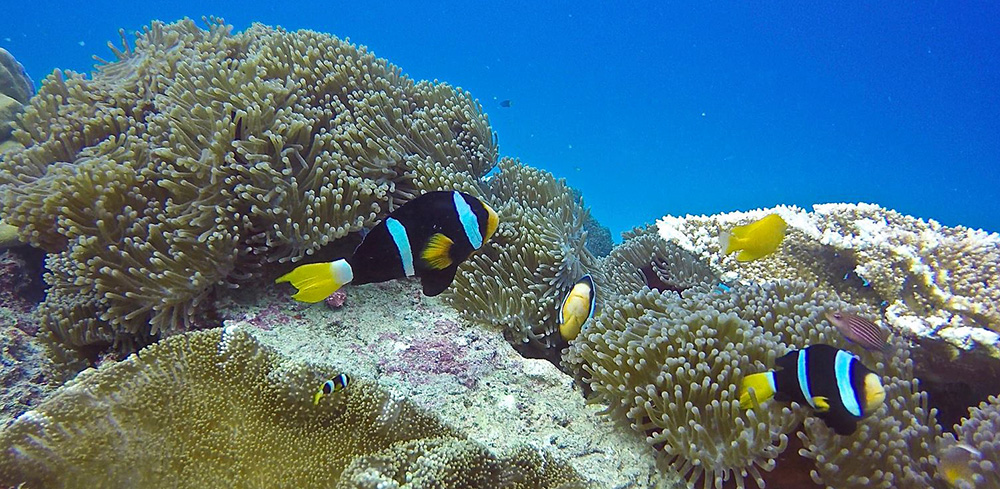
Anemone fish, Asu Island, Hinakos. Photo courtesy of www.puriasuresort.com
So where to go snorkelling and freediving on Nias? The best places are often found off the small islands that dot the Nias coastline. Another rule of thumbs is to avoid the areas facing directly west where the pounding waves makes it unsafe to swim. On the east coast stay away from the river mouths, as the visibility may not be the best there, especially after heavy rains. Here is a list of our favourite locations:
North Nias (Nias Utara)
Tureloto N 1.432973°, E 97.145968°
Tureloto is a place very popular with locals as it is easily accessed from nearby Lahewa. It’s huge lagoon protects swimmers from waves and currents. But the best snorkelling can be found outside the lagoon where the water is clear and there is plenty of fish and colourful corals to see. Enter the water anywhere in Torelotu and swim across the lagoon. The top of the reef is usually exposed and you can see a few channels where it’s possible to swim out of the lagoon. The outside reef facing the ocean is where there is most fish and colourful corals. You can also hire a small boat that will take you to the outside reef.
Asi Walo N 1.51034°, E 97.42496°
Asi Walo is a small but very nice bay on the east coast of North Nias. The location is easily accessible and there is a small beach café here catering for local tourists. The beach is inside a natural harbor making it a good, safe location for swimming and snorkelling. The reef has been damaged in places but there are still very interesting snorkelling areas just off the beach, especially out towards the edges of the small bay.
Asi Walo Beach is located in the north east corner of Nias Island, in Sawo sub-district. To get here just drive the main coastal road northwards from Tuhemberua to Teluk Bengkuang village. The turnoff is right next to a large church.
Wunga Island N 1.22191°, E 97.09294°
Wunga Island on the west coast of Nias has some spectacular reef sections and the water is very clear here. The best place for snorkelling is outside the entrance to the lagoon. Enter the water from the beach on either side or from a boat. Swim out to the middle of the channel towards the outside, where it is between 2-4 meters deep. After exploring the channel turn left or right and follow the coastline one either side of the channel. After a slow start the reef becomes very interesting a couple of hundred meters from the channel. Visibility changes with the tide; when the tide is falling water is going out of the channel and it is not as clear as when the tide is rising. Beginners can stay further into the lagoon where its shallower, while experienced swimmers may venture further out.
Another good snorkelling spot can be reached by boat c. two kilometers south of the lagoon entrance on the east side of the Island. Look for a small rock protruding out of the water just off the shore (N 1.20485°, E 97.10357°). Wunga Island can be reached by boat from Afulu. The trip takes about 1.5 hours with a local boat.
Gosong Uma Islands N 1.46217°, E 97.20261°
Gosong Uma Islands were created during the 2005 earthquake when there was a 2-3 meters uplift of the land in this area. It’s basically an uplifted coral reef where low bushes have started to grow. Some areas have been damaged but there are several good sections here; both sides of the smaller island has nice reefs as well as the channel between the islands. To get to Gosong Uma take a boat from Lahewa or Lafau village. The trip usually takes 30-40 minutes.
Hinako Islands
Hinakos is the name of a group of eight islands off the west coast of Nias. The best known island is Pulau Asu which is famous for world class surfing and because it has some very nice beach accommodation. The water around Hinakos is often very clear and the reefs and marine life are some of the best on Nias. Snorkellers base themselves on Asu Island and can explore some great spots here or charter a boat to explore further afield.
Asu Island has some of the best spots for snorkelling on the protected east (inner) side of the island. Kids and beginner snorkellers can have a great time right off the beach in front of Mama Silvis Cottages or Puri Asu Resort. Experienced snorkelers should try the better reef sections towards the south end or north. To reach the south end walk along the village track to the first aid station (Puskesdes), turn off to the left until you get to a dilapidated pier. Jump in here and swim south. After some 500 meters the swell start to pick up as you get close to the surf zone. This area actually has the best reef and turtles are often seen here. For the north end, walk toward Asu Surf Camp and the main surf wave. As you pass the ruins of an abandoned resort enter the water at a small beach. Swim north for a couple of hundred meters until reaching an area with very good corals and rock formation. The reef ends near the surf zone. Turn around before the swell becomes too big.
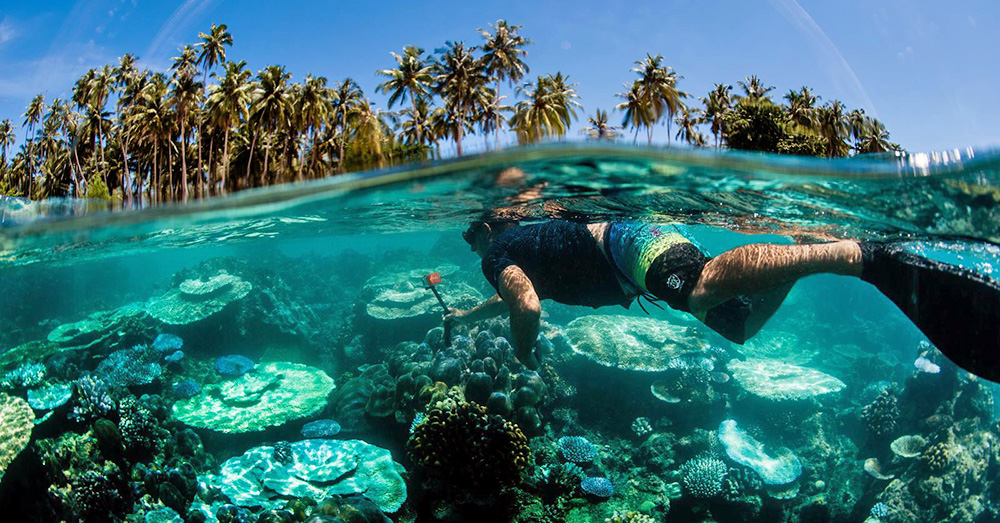
Snorkeling on Asu Island. Photo courtesy of www.puriasuresort.com
Visitors often hire boats on Asu to explore the other islands of Hinakos. The boat driver usually knows where the best snorkelling spots are, but here are some highlights:
Goso Olayama N 0.905670°, E 97.288896°
One kilometer off the main beach on Asu is a shallow underwater reef (called Goso in Nias Language) which can be easily reached by boat from Asu. Large schools of fish are often seen here.
Pulau Langu N 0.880671°, E 97.368506°
East corner; amazing table corals and often very clear. White-tipped reef sharks have been spotted here.
Goso Buku N 0.852198°, E 97.339665°
This submerged reef in the channel between Hinako and Himana Island always has a lot of fish. The current may be strong here. In that case ‘drift’ snorkel, i.e. enter the water up-current from the reef and drift pass. The boat should follow the snorkellers, not anchor.
Bawa Wreck N 0.826653°, E 97.361736°
There is an old steamship wreck on the east coast of Bawa island. If there is too much swell this spot is not safe.
East Coast Islands
Due to the many rivers on the east-coast of Nias the water is not very clear here, with the exception of four small islands off the coast of Central Nias Regency (Nias Induk). These tropical paradise islands usually have clear water and healthy corals with lots of colourful reef fish. White and black-tipped reef sharks are regularly sighted here.
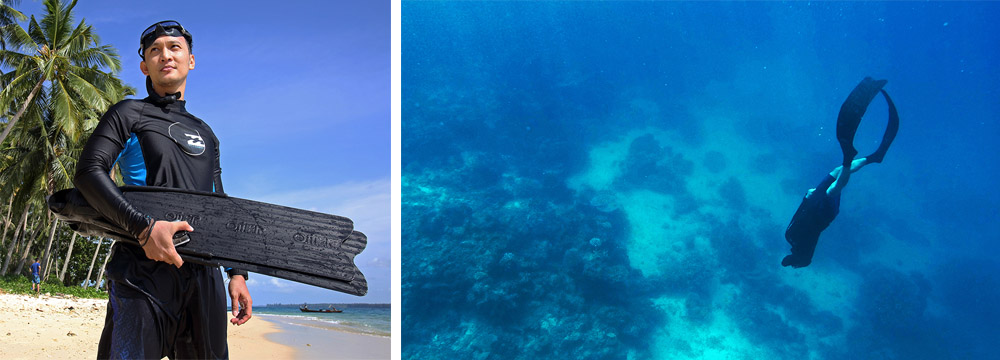
Local freedivers from Gunungsitoli exploring Onolimbu Island.
Onolimbu N 1.075696°, E 97.904253°
This is the largest island in this area. There is a nice beach on the west side of the Island. The best snorkelling can be found by walking northward along the beach until it ends. Enter the water here and keep swimming north to the best section of the reef.
Pulau Musi N 1.079867°, E 97.929534°
A small uninhabited island 2.5 km east of Onolimbu. This is another great spot for snorkelling. Being even further off the mainland the water is often clearer here. Just like Onolimbu, the best snorkelling can be found in the northern corner of the island. Pulau Musi is so small that it is possible to snorkel around the whole island in an hour or two.
Pulau Soma N 1.024781°, E 97.9545530°
Pulau Soma is 8 km southeast of Onolimbu and has very similar features. Snorkelling is beast on the northern side. On the north-east side of the island there is a wreck from a ship that sunk in 2004. To find the wreck just follow the reef and look for debris on the bottom. The top of the boat is only a few meters deep and during low-tide its possible to freedive into the wheel-house.
Pulau Somambawa N 1.022925°, E 97.965652°
A tiny island one kilometer east of Pulau Soma. It is small enough to swim around the whole island. 1.5 kilometers north-east of this island there is an interesting Goso (underwater reef) that can be visited if its not too choppy.
To get to the islands you need to arrange a boat from Gunungsitoli or nearby Bözihona village. From town takes almost 3 hours and you need a large boat. In Bözihona there are many small boats and the trip to the island is not that long. But getting to Bözihona involved a 45 km drive from town on some very rough roads. Enquire with Go Nias Tours about exploring these Islands.
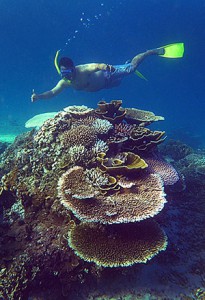
Snorkelling at Luluang Beach, Telos. Photo courtesy of Telloku.
Telos (Batu Islands)
This group of islands south of Nias is also knows as 101 islands. The many islands and submerged rocks in this archipelago makes it perfect for diving and snorkelling. An absence of large rivers or towns means that the water here is usually clearer than elsewhere on Nias. Due to the remoteness of these islands much of the reefs here remains unexplored. Guest staying at the surf-resorts in the north talk about spectacular underwater landscapes seen while snorkelling. This is the new underwater frontier of Nias waiting to be explored by scuba divers and snorkellers. Locals mention Luluang Beach on Telo Island as one of the best places for snorkelling.
Scubadiving on Nias Island
Scuba diving looks very promising on many locations around Nias, but most of the island remains unexplored by divers. Currently the only place to rent diving gear and fill tanks on Nias is Puri Asu Resort on Asu Island. Scuba divers who want to dive in the Hinakos should book into Puri Asu Resort, or contact them to discuss the possibility of joining their diving excursions or getting tanks filled there.
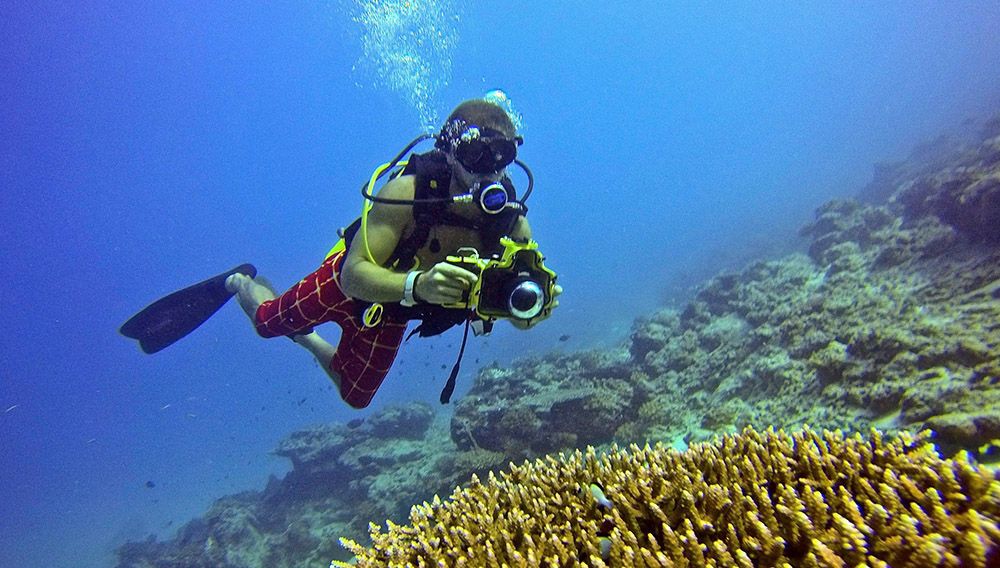
Scuba diving with Marcelo Noto from Puri Asu Resort, currently the only place on Nias that offers Scuba Diving. Photo courtesy of www.puriasuresort.com
Reef damage
Like elsewhere in Southeast Asia reef on Nias have been damaged in places by bomb-fishing, fish poison and careless anchoring. Fortunately the local authoritarians now actively pursue the worst culprits and many damaged areas are recovering. In 2016 a coral bleaching event took place on Nias and surrounding islands. Record levels of rain fell and unusually large amounts warm, muddy river water flowed out into the sea for months. This raised the water temperature, lower salinity levels and covered the coral reefs in silt. This is believed to be the trigger for the coral bleaching that took place. It will take a few years for the reefs to fully recover.


